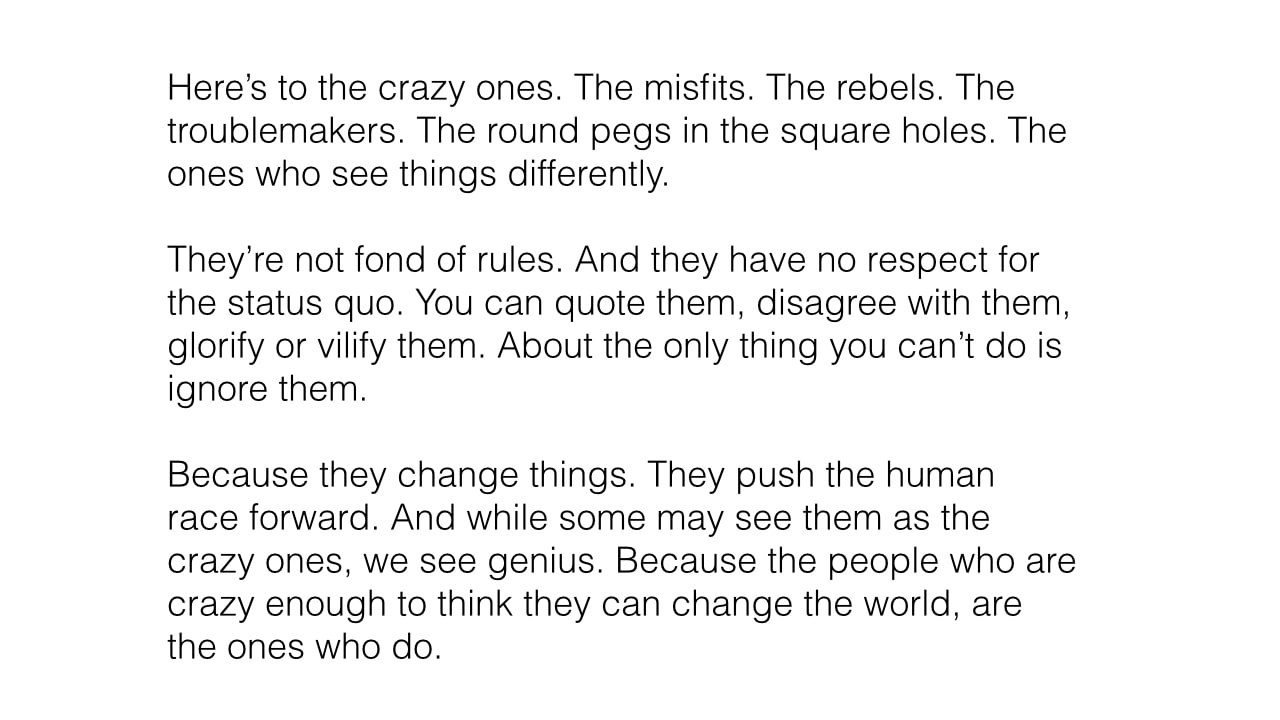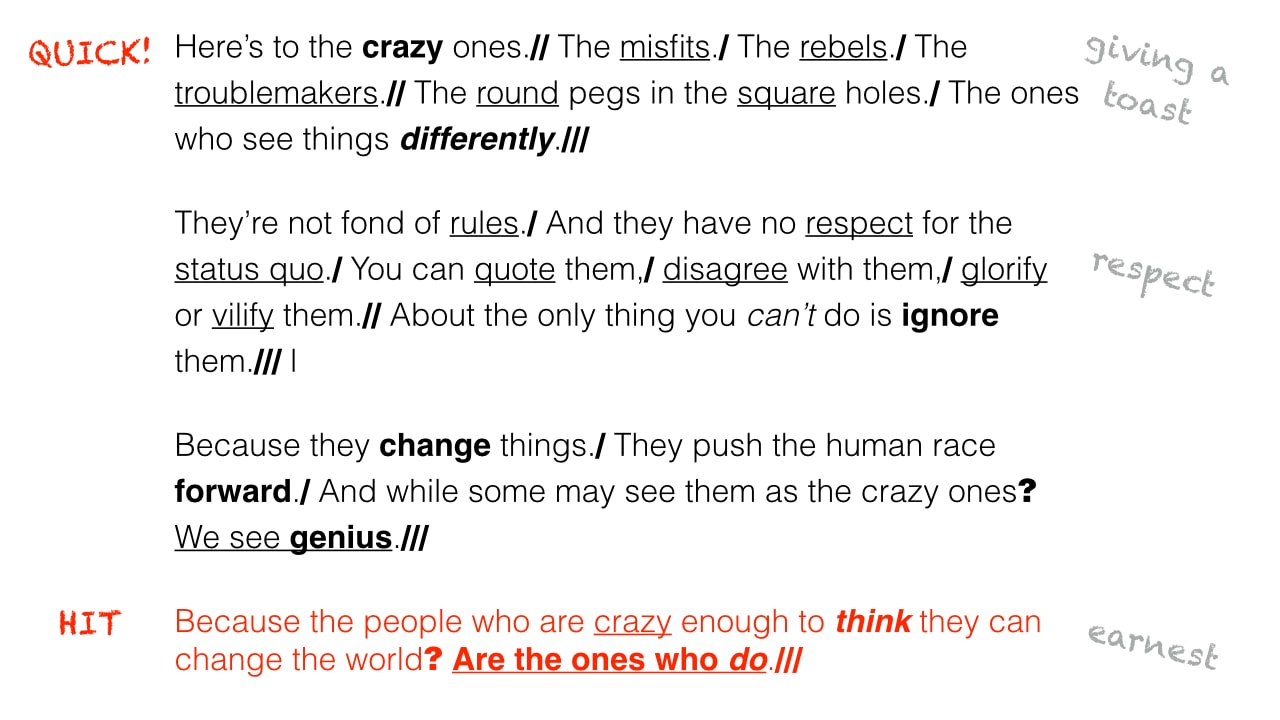You have the structure. You have the words. But a great talk goes way beyond words. In a recent study, the ratings for the most popular TED talks were the same whether the viewers watched with or without the sound on.
Why? Because the speakers were able to convey meaning with everything else at their disposal: their gestures, their movement, their faces.
That means you have to know not just the words and ideas in your talk or presentation, but the meaning behind them, as well.
And obviously, your audience or customer will hear you. And when they do, the mechanics of conveying meaning – pacing, pausing, emphasis, etc. – need to be there, too.
MAKING YOUR SCRIPT SERVE YOU
There’s a saying that “practice makes permanent,” so we need to back up a bit and make sure your script serves you. We need to make sure it tells and reminds you not just what to say, but how and why to say it.
To do that, we’re going to borrow a technique I originally learned as a singer, called script analysis (it’s “score analysis” for singers, of course). Author, speaker, and former actor Michael Port uses this technique, too. He calls it “content mapping” – a great term.
Here’s how it works: you go through a paper version of your script and physically mark it with reminders to:
- Pause and breathe
- Emphasize key words, phrases, and ideas
- Convey certain emotions and motivations
On each pass, you’ll add a different set of markings so that you have a guide from which to rehearse. Use a pencil! You’ll continue to change things until it feels just right.
Let’s use this text from Apple’s Think Different ad as an example:
Pass One: Pauses and breaths
First, read the script out loud. As you do, mark all existing punctuation – commas, periods, etc. – and where you find yourself naturally pausing for emphasis.
You’ll also want to add pauses where you find yourself running out of breath…or better yet, rewrite the sentence, because it’s probably too long.
I like to use a combination of slashes to indicate different “lengths” of pauses. Use one slash to mark what Michael Port calls a “beat.” It’s basically a “micro-pause,” the kind you make when you see a comma in a sentence.
I use two slashes for a pause (at periods, for example); and three for a full stop, break, or breath. Usually if I find a place I want three slashes, I go back into the script and just create a new paragraph.
Here’s how I marked up the ad:
Pass Two: Key words and thoughts
Again, read the script out loud. This time, identify the key word(s) in each sentence, as well as the key ideas (Port calls these “operative words). Note where you want to stress a word or phrase.
Tip: Your insight or “big idea” phrases should always be emphasized – and emphasized more strongly than anything else. They are what all your other words lead to.
You’ll see I broke that last line out into it’s own paragraph, and marked it specially:
After you’ve got everything marked, you may want to go back and edit the electronic copy of your document and translate your markings into italic, bold, all caps, highlights, larger font sizes, colors, etc. Whatever will make immediate sense to you.
You may have noticed that I changed some of the punctuation in the last couple of paragraphs. That’s another way to remind me which style of delivery I preferred.
Pass Three: Emotion and motivation
Emphasis is important, but not everything is emphasized the same way. You sound very different when you’re curious than when you’re concerned, for example.
So the final pass is to go through your script one last time and write in the motivation or emotion for each section. WHY are you saying it? What’s the emotion behind it? What do you want the audience to feel? (Because they will mimic your feeling without even realizing it.)
You may want to find a list of emotions or adjectives to help you. Here’s one list from Gina Razon, a speech and voice coach, and one of the speakers we coached for TEDxCambridge.
One more thing…pace.
There’s one more set of markings you may want to make, and those have to do with pace – how quickly or slowly you deliver certain phrases or sections.
Pace is an important part of a natural delivery. In normal conversation, we naturally speed up on less important details (“So I was driving in my car the other day on my way to the gym…”) and slow down on the important ones (“…when all of a sudden…a kid…ran OUT…RIGHT…in FRONT…of my CAR!”).
Since you’ve already marked the pauses, emphasis, and emotion on your other passes, a few last reminders about overall pace can be helpful:
- “Quick” for those areas that you want to make sure move quickly and don’t drag (think: setup, exposition, and details of stories)
- “Care” for explaining new or complex concepts, or for phrases that sometimes trip you up
- “Hit” for your key takeaways.
I find script analysis to be a straightforward, but wildly effective tool, both for myself and the speakers we coach. I think you can see how it can prompt you, even when you’re seeing text for the first time, to read it in a way that sounds like you’re speaking the text, not just reading it.
And the more you practice that? The more natural your presentation will sound.
###
Our approach to delivery coaching is different – it builds off of how you’ve designed and built your presentation in the first place. It’s an important part of our Communication Skills workshops – contact us to find out more.










